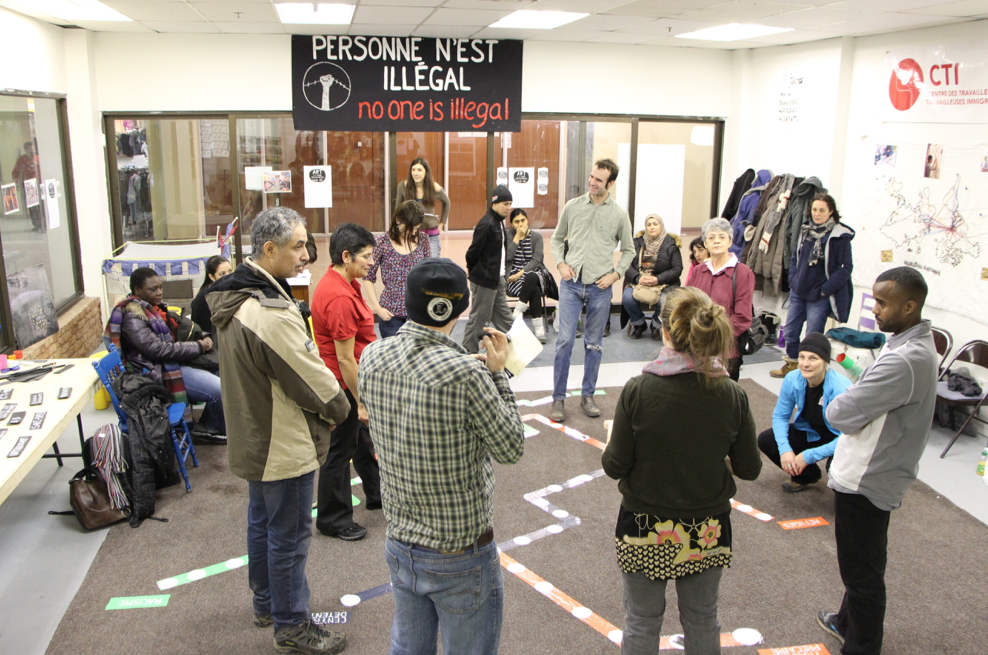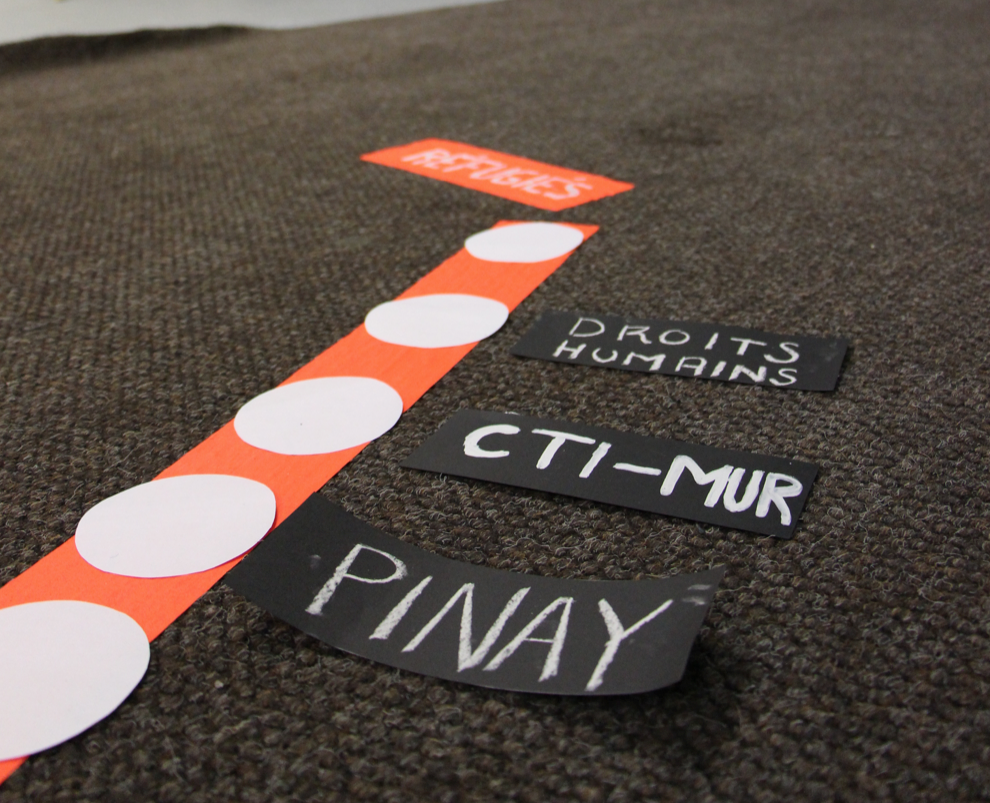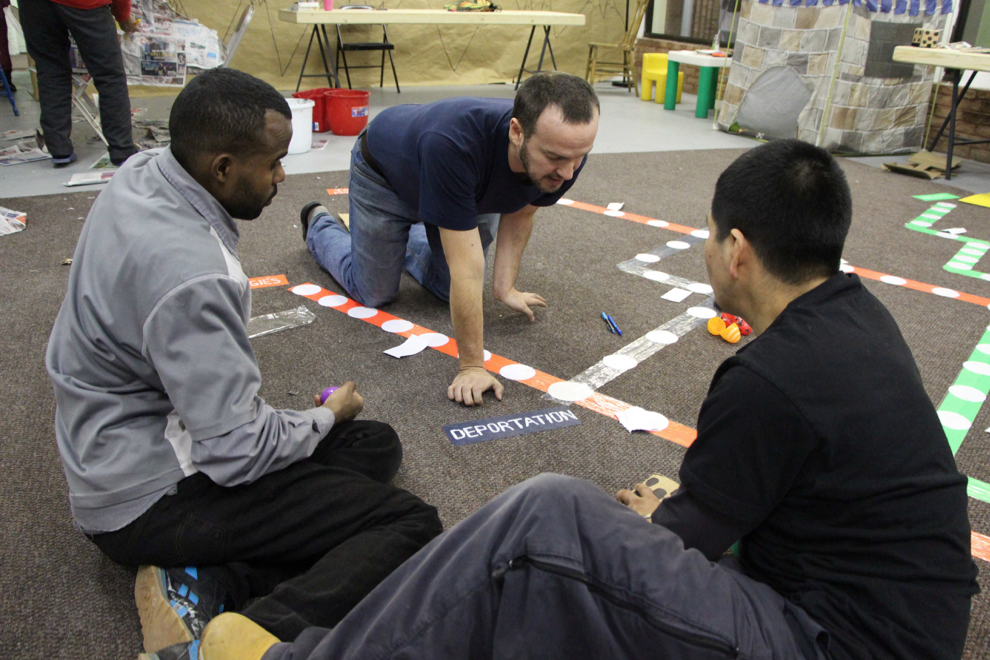The Network of Immigration – Pt. 1 : Stories & Migration
Process steps : 1 (situation analysis) and 3a (mobilise to action)
Objectives
To appropriate visual representations of one’s experience, and by mixing symbols, visual iconography, language and stories, re-present one’s realities on a recognizable map. Allows for reflections on geo-political experience of space, and intervention on the means of representations of movement and identity in these locations. Together group participants build a common understanding of systemic issues to the scale of a map (city, subway system, or otherwise).
Artistic medium : Physical theatre
Duration : Between 45 min. and 1h30 (depending on the number of people)
Material
A large-scale floor-size reproduction of the map you choose to work with.
Prepared cut out pieces of different coloured cardboard paper and pens, set to the side.
Illustrative example
This container was created as the first of three workshops during an Artists’ Bloc public art residency at the Plaza Côte-des-Neiges shopping mall. With a residency locale open to passersby, the goal was to create an interactive environment that would visually draw people in to the work, then allowing them to directly intervene upon it, as well as display the traces of past contributors.
This works then both as a public art installation, an archive of experiences, and a designated public workshop (and can be adapted to multiple interactions at once, or the accumulation of single contributions over time). Here the work is described in its designated workshop setting.
This was successful as the second unit to a public workshop. In the first section members of the Artists’ Bloc presented a short skit as well as information on the conditions of immigrant workers in Montreal, and the work of the IWC (Immigrant Workers Center). There was time for a dialogue with the public, and for people to ask questions about their work.
After a short break, we reconvened with Artists’ Bloc members and participants to explore the city of Montreal together, by way of a large-scale floor map of the Montreal metro system we had laid on the ground. People reassembled in a circle around this visual art piece in order to begin this collective workshop.

Photo credit : The Network of Immigration – Stories & Migrations, workshop facilitated by the Artists’ Bloc of the IWC. (foreground, l to r: Artists’ Bloc members Manuel Salamanca, Koby Rogers Hall, and Mohamed Ben Ali). Plaza Côte-des-Neiges, February 2015. Photo taken by Patrick Landry.
Progress
Step 1 :
Invite participants to each identify a station on the map that has significance for them (this can be their home, place of work, or a place where something memorable happened to them…). Invite each person to physically stand on/by the station they have chosen. One by one, proceed by asking each participant: “what station are you at?” and “why have you chosen that station?” They are invited to respond by sharing with the group. Be sure to invite the same, one by one, from everyone in the room.
Step 2 :
Now that they have listened to everyone, invite participants to proceed to the area where they can find cut out paper and pens (In our case, they were set out on a table adjoining the floor map area). Invite them to think of one or two keywords – this can be something they heard in someone’s story, or something that came up for them. Have them write one word per piece of paper, and then bring these with them as they come back to the map.
Here ask them to now pick a station that goes with the themes they have chosen. Once more, ask them to stand on their station. One by one, move through the group by asking them: “what station are you at?” and “why did you choose that station?”. Allow them to make connections as they wish with the new words they discovered.
When everyone has spoken, invite them to place their cards with keywords now on or beside the stations they designated.
Invite people to individually observe (for themselves) this newly created map together.

Photo credit : The Network of Immigration – Stories & Migrations, workshop facilitated by the Artists’ Bloc of the IWC. Plaza Côte-des-Neiges, February 2015. Photo taken by Patrick Landry.
Step 3 :
If some people find themselves already standing at the same station, invite them to discuss in smaller groups what they find as similarities, and what they experience as differences.
Step 4 :
If participants identified with one of the stories or keywords they heard from others, invite them now to go stand with them at that station. They may now discuss why they moved there with the group.
Following these groupings, and for one final time, move around these groupings of people, and ask them as a newly formed group, “what station are you at?”, and “why did you choose that station?”
Step 5 :
Break out of the exercise here, and invite everyone to come back together. Discuss the tools discovered and the experiences of each participant throughout.
Are there any new questions that arise from moving around this collectively mapped storytelling? Were there any surprises or discoveries for people? What did it feel like to stand on your own? What was it like to stand together?
Is there anything more you would like to see done differently with this map?
Be sure to document everything, either throughout, or at the end of your creation process…you have now a collectively created map with the group you have been working with!
Variant
If you choose you may like to record people’s spoken responses throughout – however this requires speaking to this intention in your introduction, and obtaining participants’ consent to do so. You may find some agree, some don’t, and you adapt accordingly (either by respecting individual wishes, or doing without recording altogether). Having a clear sense of intention for what you choose to do with these recordings, and how they might be used, helps greatly in creating agreement about this.
Comments
You can prepare some of the cut-outs with keywords already on them, to help with inspiration. We had some keywords artists’ bloc members had already come up with, such as RACISM, for example, and REFUGEES.
Photo credit : The Network of Immigration – Stories & Migrations, workshop preparation by members of the Artists’ Bloc of the IWC. (from l to r: Artists’ Bloc members Mohamed Ben Ali, Manuel Salamanca, and Carmelo Monge prepare keywords for metro map facilitation). Plaza Côte-des-Neiges, February 2015. Photo taken by Patrick Landry.
This inspired some other words that participants came up with throughout the workshop including RAMQ (for the experience someone had at the RAMQ) and INVISIBLE, for their feelings of moving through the metro.
Document! You never know at what stage you may be able to continue your creation based on content generated. This may be visual, audio, or video documented interactions.
Some of the stories invited and shared may be difficult or traumatic for some to share, and for others to hear. A clear introduction to this concept before the workshop can help in setting the needs and concerns for participation, and taking care of oneself in the room. For example, naming that anyone may need to step out of the room at any point, and they should feel free to do so, also to ask for one of the facilitators to accompany them if so needed.
Do not force participation – some people may step out at some points; they key is to keep them actively involved, as they can contribute as witnesses to these stories from the side lines. Furthermore, think of accessibility and mobility issues for your group (if some people can’t stand so long, you may incorporate chairs, more breaks, etc.)
Be mindful if some are speaking a lot, and be sure to survey people throughout the room – keeping the energy moving is key, and this provides a great listening exercise for the group. This exercise will vary greatly from a group who already knows each other to those who don’t – you will be called on as a facilitator to navigate group dynamics therein.
This mapping can be transposed anywhere to any relevant geo-political representation (stations become street names, city capitals, etc.); what is the terrain you would like to renegotiate with participants? There are inherent tensions within mapping and documentation that can be opened up here in a playful and meaningful way with participants in your project.
Writing : Koby Rogers Hall
Sources :
Originally created with the Artists’ Bloc, during residency with Projet MU and the Festival TransAmeriques; at the Plaza Cote-des-Neiges (jan. – feb. 2015).
Inspired by the traditions of community mapping projects, such as the Iconoclasistas activist mapping projects in Cordoba, Argentina. http://www.iconoclasistas.net/

